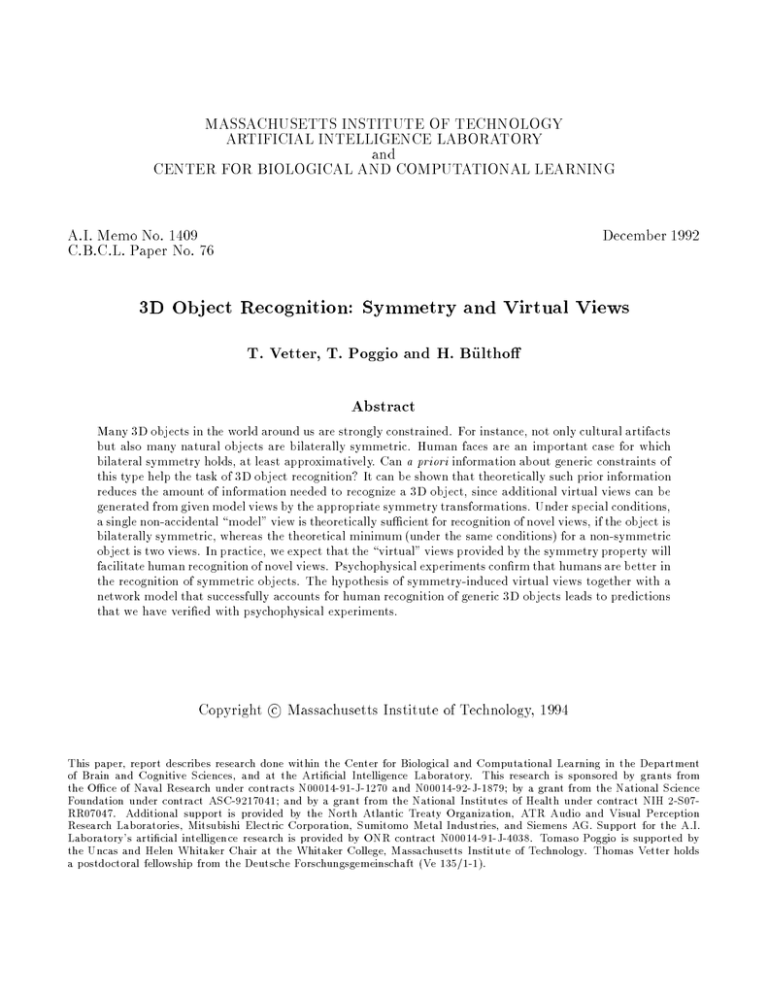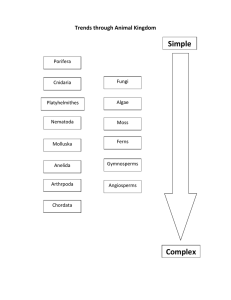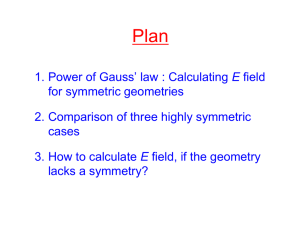MASSACHUSETTS INSTITUTE OF TECHNOLOGY ARTIFICIAL INTELLIGENCE LABORATORY and
advertisement

MASSACHUSETTS INSTITUTE OF TECHNOLOGY
ARTIFICIAL INTELLIGENCE LABORATORY
and
CENTER FOR BIOLOGICAL AND COMPUTATIONAL LEARNING
A.I. Memo No. 1409
C.B.C.L. Paper No. 76
December 1992
3D Object Recognition: Symmetry and Virtual Views
T. Vetter, T. Poggio and H. Bultho
Abstract
Many 3D objects in the world around us are strongly constrained. For instance, not only cultural artifacts
but also many natural objects are bilaterally symmetric. Human faces are an important case for which
bilateral symmetry holds, at least approximatively. Can a priori information about generic constraints of
this type help the task of 3D object recognition? It can be shown that theoretically such prior information
reduces the amount of information needed to recognize a 3D object, since additional virtual views can be
generated from given model views by the appropriate symmetry transformations. Under special conditions,
a single non-accidental \model" view is theoretically sucient for recognition of novel views, if the object is
bilaterally symmetric, whereas the theoretical minimum (under the same conditions) for a non-symmetric
object is two views. In practice, we expect that the \virtual" views provided by the symmetry property will
facilitate human recognition of novel views. Psychophysical experiments conrm that humans are better in
the recognition of symmetric objects. The hypothesis of symmetry-induced virtual views together with a
network model that successfully accounts for human recognition of generic 3D objects leads to predictions
that we have veried with psychophysical experiments.
c Massachusetts Institute of Technology, 1994
Copyright This paper, report describes research done within the Center for Biological and Computational Learning in the Department
of Brain and Cognitive Sciences, and at the Articial Intelligence Laboratory. This research is sponsored by grants from
the Oce of Naval Research under contracts N00014-91-J-1270 and N00014-92-J-1879; by a grant from the National Science
Foundation under contract ASC-9217041; and by a grant from the National Institutes of Health under contract NIH 2-S07RR07047. Additional support is provided by the North Atlantic Treaty Organization, ATR Audio and Visual Perception
Research Laboratories, Mitsubishi Electric Corporation, Sumitomo Metal Industries, and Siemens AG. Support for the A.I.
Laboratory's articial intelligence research is provided by ONR contract N00014-91-J-4038. Tomaso Poggio is supported by
the Uncas and Helen Whitaker Chair at the Whitaker College, Massachusetts Institute of Technology. Thomas Vetter holds
a postdoctoral fellowship from the Deutsche Forschungsgemeinschaft (Ve 135/1-1).
1 Introduction
It is well known that a 3D object can be recognized irrespective of pose if a 3D model or a sucient number
of 2D (model) views are available, together with the correspondence of their feature points. Under the assumption of orthographic projection and in the absence of
self-occlusions, the theoretical lower limit for the number of necessary views is two ( 1.5 views theorem, see
Poggio, 1990 and Ullman and Basri, 1991). A view is
represented as a 2 vector 1 1 2 2
N N of
the coordinates on the image plane of labeled and
visible feature points on the object. All features are assumed to be visible, as they are in wire-frame objects
(see gures 1,2). The generalization to opaque objects
follows by partitioning the viewpoint space for each object into a set of \aspects" [5], corresponding to stable
clusters of visible features.
Psychophysical experiments [1] using wire-frame and
other objects suggest that a relatively small number of
views { but higher than two and probably between 20
and 100 { are used by the human visual system, which
seems capable of generalizing to novel views by \interpolating" between the few model views. These experiments
are consistent with a network model proposed by Poggio
and Edelman (1990), in which each hidden unit is similar
to a view-centered neuron tuned to one of the example
views (or to prototypical views) whereas the output can
be view-independent if enough training views are provided.
Often we are able to recognize 3D objects on the sole
basis of their shape after seeing only one view. This is
the case for faces, at least to some extent. It is therefore
interesting to ask in general whether invariance properties of the object may reduce the number of model views
necessary for recognition.
N
x ; y ; x ; y ; : : :; x
;y
N
2 Exploiting Bilateral Symmetry for
Recognition
Classes of objects with parallel faces and objects with
orthogonal faces, such as most man-made objects, provide interesting examples of such invariance properties.
It can be shown that they are instances of so called linear classes of objects [12]. Information that an object
belongs to one of these classes reduces the number of
required model views. A particularly interesting example is the class associated with the property of bilateral
symmetry. It is easily shown [12] that, given a model
view { such as the one in gure 1a { and prior information that the corresponding 3D object is bilaterally symmetric, other \virtual" views can be generated by the
appropriate symmetry transformations (see gure 1b).
It seems plausible that these new virtual views contain
additional information that can be exploited for better
recognition. In the special case of orthographic projection with views dened as above the intuition can be
made precise: for any bilaterally symmetric 3D object,
one non-accidental 2D model view is sucient for recognition [12]. Notice that in this proof a perfectly frontal
view is an accidental view and is not sucient by itself
for recognition of novel views. One does not need to
know the symmetry plane but simply the pairs of symmetric point features. Symmetries of higher order than
bilateral allow the recovery of structure from just one
2D view [12]. Also in the perspective case symmetry is
a useful constraint [4, 7] for recognition.
3 Psychophysics
While the theoretical results [12] establish a minimum
number of model views needed for recognition of bilaterally symmetric objects, a practical prediction for the
psychophysics of object recognition is that fewer views
should be needed in the case of symmetric relative to
asymmetric objects (see gure 2) for the same level of
generalization from a single model view. This is a general prediction, independent of the specic recognition
scheme, and it only assumes that the visual system can
exploit the information contained in bilateral symmetry which allow to generate virtual views from the given
ones. It is reasonable to expect that recognition of symmetric objects is also done in a suboptimal way, since
in the case of non-symmetric objects the human visual
system needs [1, 6] signicantly more model views (20100) than the theoretical minimum of two (which is valid
for orthographic projection only and, more importantly,
for very specic view features { the
coordinates of
corresponding points).
If we consider the interpolation-type or classication
models for visual recognition { such as HBF networks
{ that are supported by the psychophysical experiments
of Bultho and Edelman (1992), we can make a more
specic prediction. For each example view used in training, the RBF version of the HBF network (see Poggio
and Edelman, 1990) allocates a center, that is a unit
with a Gaussian-like recognition eld around that view.
The unit performs an operation that could be described
as \blurred" template matching by measuring the similarity of the view x to be recognized with the training
view t to which the unit is tuned. The activity of the
unit depends then on this similarity through a Gaussian
function (jjx ; tjj). At the output of the network the
activities of the various units are combined with appropriate weights, found during the learning stage. In the
more general HBF scheme the number of units, that is
templates, used during recognition may be less than the
number of training views and in addition the appropriate
similarity metric is found automatically during learning
(see Poggio and Girosi, 1990). An example of a recognition eld measured psychophysically for an asymmetric
object after training with a single view is shown in gure 3a. As predicted from the model (see Poggio and
1 Edelman, 1990), the shape of the surface of the recognix; y
G
tion errors is Gaussian-like (more precisely a monotonic
transformation of a Gaussian) and is centered around the
training view. In the case of symmetric objects, the prediction is that the system exploits symmetry by creating
from a single training view additional virtual views and
allocating the corresponding new centers, as shown in
gure 1a,b. The expected overall eect, as measured by
the psychophysical technique of Bultho, Edelman and
Sklar (1991), would then be a broader, possibly multipeaked recognition eld.
Our experimental data are in agreement with both
these predictions. Recognition of novel views given a
single training view is signicantly better for symmetric than for asymmetric objects (77% correct versus 64%
correct, averaged over all testing views). In addition, the
recognition eld is, as expected, multipeaked and elongated (gure 3b) in the correct direction, orthogonal to
the symmetry plane. Figure 4 shows that the broadening
of the generalization eld occurs for symmetric objects
exactly in the direction of the closest virtual view and
that by increasing the distance of the virtual view it is
possible to resolve the expected two peaks.
A remark about the physiological implications of our
results is in order here. Suppose that training to a view
of a 3D object creates a group of neurons tuned to that
view. In the case of bilaterally symmetric objects the
virtual views induced by symmetry may correspond to
dierent neurons specically tuned to them. A perhaps
more likely alternative is that features with the appropriate symmetry invariance (see Moses and Ullman, 1991)
are used (instead of
position of feature points), in
which case the same neurons tuned to the training view
would also respond to the virtual views induced by symmetry.
The key problem in all schemes for learning from examples, such as RBF networks and various types of neural networks, is the number of required examples for a
given task. Often an insucient number of examples are
available or obtainable. A case in point is the recognition
of a 3D object, such as a face, from a single training example (i.e., a model view). An attractive solution to this
general problem is to exploit prior information to generate additional examples from the few available. We
have already shown that prior information about bilateral symmetry and other geometrical properties of objects such as collinearity and edges at right angles, could
be used in theory to do just that [12]. Here we have provided evidence that the brain seems able to exploit this
type of prior information and seems to do so consistently
with a model of recognition that is based on the memory
of the training views { possibly through neurons tuned
to them { and of the virtual views induced by symmetry.
Several open questions remain. It is natural to speculate that visual recognition of 3D objects may be the
main reason for the well known sensitivity of our visual
system to bilateral symmetry. How does then our visual 2
x; y
Figure 1: Given a single 2D model view (upper left), a
virtual view (upper right) can be generated by an appropriate transformation induced by the assumption of bilateral symmetry (under orthographic projection). This
transformation exchanges the x coordinates of bilaterally symmetric pairs of features, and changes their sign
(see Poggio and Vetter, 1992). The operation leads to
a virtual view which is not a simple mirror image (note
the labels indicating corresponding points!) and which
is a \legal" view of the 3D object: the views in the upper left and upper right are images of the same 3D object appropriately rotated. Other legal views (below left
and right, for instance) can be generated by appropriate transformations associated with bilateral symmetry:
each of these other views can be obtained, however, as
a linear combination of the two above views. The images at the top left and bottom left, can be interpreted as
the image of a (transparent) object seen from two dierent viewpoints, simply by exchanging symmetric feature
points. These two interpretations (a nd c) are similar
to the bistable perception of the Necker cube type, which
therefore provides an actual and a \virtual" view of a
bilaterally symmetric object.
a
Non-Symmetric
58
59
68
64
67
71
70
59
55
60
66
75
72
62
67
69
71
57
57
64
66
63
58
58
b
Symmetric
75
67
a
78
83
78
80
81
77
82
76
80
78
74
79
71
74
76
83
81
77
83
76
70
68
Figure 3: The generalization eld associated with one
b
Figure 2: (a) The model view of a 3D non-symmetric
object (center). The surrounding images show examples
of other views (30 rotation around horizontal or vertical
axis) of the same object used for testing generalization to
dierent view points. In the experiment, novel views are
presented intermixed with distractors, that is views of
other similar objects (see Bultho and Edelman, 1992).
(b) An example of the bilaterally symmetric objects used
in our psychophysical experiments.
3
training view of non-symmetric objects (a) (see also
Edelman and Bultho, 1992) and symmetric objects (b).
The recognition performance for wire-like objects (see
gure 2) increases with distance from the training view
roughly (since the exact nature of the feature space is unknown) as expected for a Gaussian-like unit tuned to the
training view (a). In (b) the generalization eld is multipeaked (see gure 4a) and elongated in the horizontal direction as expected from the presence of additional units
tuned to the virtual views induced by symmetry of the
objects. The generalization eld is dened as the recognition rate for views similar to the training view: means
of error rates of 14 subjects and 32 dierent objects are
plotted vs. rotation in depth around the two axes in the
image plane. The extent of rotation was 90 in each direction; the center of the plot corresponds to the training
attitude. The numbers represent the mean percentage of
correct recognized target objects and correct rejected distractor objects (Hit + CR). Target and distractor objects
were randomly displayed in equal proportions.
a
system detect symmetric pairs of features? Some of the
natural strategies (see for instance Reisfeld, Wolfson and
Yeshurun, 1990) would require extensive and specialized
circuitry in the visual system and neurons specialized in
detecting bilaterally symmetric features such as the virtual lines connecting pairs of bilaterally symmetric feature points (that are always parallel to each other). Is
it possible to extend our results to geometric constraints
other than bilateral symmetry? Can neurons be found,
possibly in IT, with recognition elds consistent with the
psychophysics (gures 3a,b) and the model? Another
important set of questions concerns how to learn class
specic transformations { for instance the transformation that \ages" a face { and whether the brain indeed
can learn and use them to eectively generate additional
virtual model views for tasks of recognition.
Acknowledgments
We are grateful to F. Girosi and A. Hurlbert for useful
discussions and suggestions.
References
b
Figure 4: The graphs show the recognition performance
over a (90 ) rotation range around a xed axis. The
object was presented at 0 . The data in (a)is taken from
gure 3b. In this situation the virtual views were located
at 90 (thin arrows); In (b) the virtual views were at
54 (thin arrow) and at ;126 (not shown), as a consequence of a dierent orientation of the training view. In
both cases, the graph shows peaks at the location of the
virtual views, as predicted.
[1] H. H. Bultho and S. Edelman. Psychophysical support for a 2-D view interpolation theory of object
recognition. Proceedings of the National Academy
of Science, 89:60{64, 1992.
[2] H. H. Bultho, S. Edelman, and E. Sklar. Mapping the generalization space in object recognition.
Invest. Ophthalm. Vis. Science Suppl., 32(3):996,
1991.
[3] S. Edelman and H. H. Bultho. Orientation dependence in the recognition of familiar and novel views
of 3D objects. Vision Research, 32:2385{2400, 1992.
[4] G. G. Gordon. Shape from symmetry. Proc.
of SPIE, Intellegent Robots and Computer Vision,
1192:297{308, 1989.
[5] J. J. Koenderink and A. J. van Doorn. The internal
representation of solid shape with respect to vision.
Biological Cybernetics, 32:211{217, 1979.
[6] Z. Liu, D.C. Knill, and D. Kersten. Object classication for human and ideal observers. 1993. submitted for publication.
[7] H. Mitsumoto, S. Tamura, K. Okazaki, and
Y. Fukui. 3-D reconstruction using mirror images based on a plane symmetry recovering method.
IEEE Transactions on Pattern Analysis and Machine Intelligence, 14(9):941{946, 1992.
[8] Y. Moses and S. Ullman. Limitations of non modelbased recognition schemes. A.I.Memo 1301, Articial Intelligence Laboratory, Massachusetts Institute of Technology, 1991.
4
[9] T. Poggio. 3D object recognition: on a result by
Basri and Ullman. Technical Report # 9005{03,
IRST, Povo, Italy, 1990.
[10] T. Poggio and S. Edelman. A network that learns
to recognize 3D objects. Nature, 343:263{266, 1990.
[11] T. Poggio and F. Girosi. Regularization algorithms
for learning that are equivalent to multilayer networks. Science, 247:978{982, 1990.
[12] T. Poggio and T. Vetter. Recognition and structure
from one 2D model view: observations on prototypes, object classes and symmetries. A.I. Memo
No. 1347, Articial Intelligence Laboratory, Massachusetts Institute of Technology, 1992.
[13] D. Reisfeld, H. Wolfson, and Y. Yeshurun. Detection of interest points using symmetry. Proceedings
of the 3rd International Conference on Computer
Vision, pages 62{65, 1990.
[14] S. Ullman and R. Basri. Recognition by linear
combinations of models. IEEE Transactions on
Pattern Analysis and Machine Intelligence, 13:992{
1006, 1991.
5




